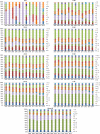Identifying patterns of non-communicable diseases in developed eastern coastal China: a longitudinal study of electronic health records from 12 public hospitals
- PMID: 28982812
- PMCID: PMC5639982
- DOI: 10.1136/bmjopen-2017-016007
Identifying patterns of non-communicable diseases in developed eastern coastal China: a longitudinal study of electronic health records from 12 public hospitals
Abstract
Objective: Few studies have examined the spectrum and trends of non-communicable diseases (NCDs) in inpatients in eastern coastal China, which is transforming from an industrial economy to a service-oriented economy and is the most economically developed region in the country. This study aimed to dynamically elucidate the spectrum and characteristics of severe NCDs in eastern coastal China by analysing patients' longitudinal electronic health records (EHRs).
Setting: To monitor the spectrum of NCDs dynamically, we extracted the EHR data from 12 general tertiary hospitals in eastern coastal China from 2003 to 2014. The rankings of and trends in the proportions of different NCDs presented by inpatients in different gender and age groups were calculated and analysed.
Participants: We obtained a total sample of 1 907 484 inpatients with NCDs from 2003 to 2014, 50.05% of whom were men and 81.53% were aged 50 years or older.
Results: There was an increase in the number of total NCD inpatients in eastern coastal China from 2003 to 2014. However, the proportion of chronic respiratory diseases and cancer inpatients decreased over the 12-year period. Compared with men, women displayed a significant increase in the proportion of mental and behavioural disorders (p<0.001) over time. Additionally, digestive diseases and sensory organ diseases significantly decreased among men, but not women. The older group accounted for a larger and growing proportion of the NCD inpatients, and the most common conditions in this group were cerebral infarctions, coronary heart disease and hypertension. In addition, the proportion of 21-year-old to 50-year-old inpatients with diabetes, blood diseases or endocrine diseases skyrocketed from 2003 to 2014 (p<0.001).
Conclusions: The burden of inpatients' NCDs increased rapidly, particularly among women and younger people. The NCD spectrum observed in eastern coastal China is a good source of evidence for developing prevention guides for regions experiencing transition.
Keywords: eastern coastal China; electronic health record; health policy; non-communicable diseases.
© Article author(s) (or their employer(s) unless otherwise stated in the text of the article) 2017. All rights reserved. No commercial use is permitted unless otherwise expressly granted.
Conflict of interest statement
Competing interests: None declared.
Figures


Similar articles
-
The prevalence of non-communicable diseases in northwest Ethiopia: survey of Dabat Health and Demographic Surveillance System.BMJ Open. 2017 Oct 22;7(10):e015496. doi: 10.1136/bmjopen-2016-015496. BMJ Open. 2017. PMID: 29061601 Free PMC article.
-
Non-communicable diseases in the WHO African region: analysis of risk factors, mortality, and responses based on WHO data.Sci Rep. 2025 Apr 10;15(1):12288. doi: 10.1038/s41598-025-97180-3. Sci Rep. 2025. PMID: 40210980 Free PMC article.
-
Burden of NCDs in SNNP region, Ethiopia: a retrospective study.BMC Health Serv Res. 2018 Jul 4;18(1):520. doi: 10.1186/s12913-018-3298-0. BMC Health Serv Res. 2018. PMID: 29973219 Free PMC article.
-
Non-communicable diseases, food and nutrition in Vietnam from 1975 to 2015: the burden and national response.Asia Pac J Clin Nutr. 2018;27(1):19-28. doi: 10.6133/apjcn.032017.13. Asia Pac J Clin Nutr. 2018. PMID: 29222878 Review.
-
Disparities of obesity and non-communicable disease burden between the Tibetan Plateau and developed megacities in China.Front Public Health. 2023 Jan 10;10:1070918. doi: 10.3389/fpubh.2022.1070918. eCollection 2022. Front Public Health. 2023. PMID: 36703857 Free PMC article. Review.
Cited by
-
Factors that dynamically affect provincial incidences of catastrophic health expenditure among middle-aged and elderly Chinese population-transition of disease financial risk protection from global to local.BMC Geriatr. 2022 Sep 16;22(1):759. doi: 10.1186/s12877-022-03432-6. BMC Geriatr. 2022. PMID: 36114475 Free PMC article.
-
Salt consumption and the risk of chronic diseases among Chinese adults in Ningbo city.Nutr J. 2020 Jan 29;19(1):9. doi: 10.1186/s12937-020-0521-8. Nutr J. 2020. PMID: 31996216 Free PMC article.
-
Investigation of non-communicable diseases prevalence, patterns, and patient outcomes in hospitalized populations: a prospective observational study in three tertiary hospitals.J Health Popul Nutr. 2024 Aug 20;43(1):128. doi: 10.1186/s41043-024-00599-z. J Health Popul Nutr. 2024. PMID: 39164738 Free PMC article.
-
Impact of Beijing healthcare reform on the curative care expenditure of outpatients with noncommunicable diseases based on SHA2011 and interrupted time series analysis.BMC Health Serv Res. 2021 Oct 2;21(1):1045. doi: 10.1186/s12913-021-07059-y. BMC Health Serv Res. 2021. PMID: 34600531 Free PMC article.
-
Disease composition and epidemiological characteristics of primary care visits in Pudong New Area, Shanghai: a longitudinal study, 2016-2018.BMJ Open. 2020 Nov 17;10(11):e040878. doi: 10.1136/bmjopen-2020-040878. BMJ Open. 2020. PMID: 33203636 Free PMC article.
References
-
- World Health Organization. Non communicable diseases progress monitor 2015. 2015. http://apps.who.int/iris/bitstream/10665/184688/1/9789241509459_eng.pdf (accessed 1 Apr 2016).
-
- Lim SS, Vos T, Flaxman AD, et al. . A comparative risk assessment of burden of disease and injury attributable to 67 risk factors and risk factor clusters in 21 regions, 1990-2010: a systematic analysis for the Global Burden of Disease Study 2010. Lancet 2012;380:2224–60. 10.1016/S0140-6736(12)61766-8 - DOI - PMC - PubMed
Publication types
MeSH terms
LinkOut - more resources
Full Text Sources
Other Literature Sources
